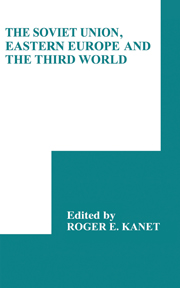Book contents
- Frontmatter
- Contents
- List of figures
- List of tables
- List of contributors
- Foreword by R.C. Elwood
- Preface by Roger E. Kanet
- PART 1 THE THIRD WORLD IN SOVIET FOREIGN POLICY
- 1 The Soviet Union and the Third World from Khrushchev to Gorbachev: the place of the Third World in evolving Soviet global strategy
- 2 Revolutionary change in the Third World: recent Soviet reassessments
- 3 Anti-Soviet insurgencies: growing trend or passing phase?
- 4 The Soviet Union and the New World Information Order
- 5 Soviet propaganda and the process of national liberation
- PART 2 CMEA ECONOMIC INVOLVEMENT IN THE THIRD WORLD
- PART 3 THE SOVIET UNION IN THE MIDDLE EAST AND SOUTH ASIA
- Index
- Publications from the Third World Congress for Soviet and East European Studies, Washington, 1985
5 - Soviet propaganda and the process of national liberation
from PART 1 - THE THIRD WORLD IN SOVIET FOREIGN POLICY
Published online by Cambridge University Press: 06 July 2010
- Frontmatter
- Contents
- List of figures
- List of tables
- List of contributors
- Foreword by R.C. Elwood
- Preface by Roger E. Kanet
- PART 1 THE THIRD WORLD IN SOVIET FOREIGN POLICY
- 1 The Soviet Union and the Third World from Khrushchev to Gorbachev: the place of the Third World in evolving Soviet global strategy
- 2 Revolutionary change in the Third World: recent Soviet reassessments
- 3 Anti-Soviet insurgencies: growing trend or passing phase?
- 4 The Soviet Union and the New World Information Order
- 5 Soviet propaganda and the process of national liberation
- PART 2 CMEA ECONOMIC INVOLVEMENT IN THE THIRD WORLD
- PART 3 THE SOVIET UNION IN THE MIDDLE EAST AND SOUTH ASIA
- Index
- Publications from the Third World Congress for Soviet and East European Studies, Washington, 1985
Summary
In his monumental study of the Bolshevik Revolution, E. H. Carr claimed that “The initiative of introducing propaganda as a regular instrument of international relations must be credited to the Soviet Government.” More than ten years later Frederick C. Barghoorn began his classic study of Soviet Foreign Propaganda by stating: “Words and pictures have played a more continuous, and perhaps a more vital role than bullets or rubles in Moscow's struggle to undermine the social order of capitalism and to reconstruct society on ‘Marxist–Leninist’ foundations.” As these authors – and many others who have been concerned with detailing the record of Soviet propaganda activities – have demonstrated, propaganda of all sorts has been an important instrument in the efforts of Soviet leaders to accomplish their foreign objectives ever since the creation of the Soviet state. During the two decades since Barghoorn published his study the foreign propaganda activities of the Soviet Union have expanded significantly and now extend across the entire world.
According to estimates of the US Central Intelligence Agency, the Soviet leadership spent more than $3 billion per year at the end of the 1970s on various forms of foreign propaganda; by 1982 the estimated cost of foreign propaganda had risen to more than $4 billion. Soviet propaganda is conducted through a broad array of activities. In 1982, for example, the Soviets published books in 68 foreign languages, primarily for distribution abroad. In English alone almost 1,200 books and pamphlets were published in more than 24 million copies.
- Type
- Chapter
- Information
- The Soviet Union, Eastern Europe and the Third World , pp. 84 - 114Publisher: Cambridge University PressPrint publication year: 1988
- 1
- Cited by



